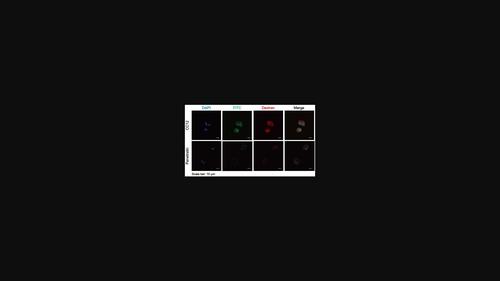当前位置:
X-MOL 学术
›
J. Pept. Sci.
›
论文详情
Our official English website, www.x-mol.net, welcomes your
feedback! (Note: you will need to create a separate account there.)
Transcytosis mechanisms of cell-penetrating peptides: Cation-independent CC12 and cationic penetratin
Journal of Peptide Science ( IF 1.8 ) Pub Date : 2022-02-06 , DOI: 10.1002/psc.3408 Minjiao Zhu 1 , Haiyang Liu 2 , Wenjiao Cao 1 , Yuefei Fang 3 , Zheng Chen 1 , Xinming Qi 4 , Dawei Luo 5 , Chong Chen 5
Journal of Peptide Science ( IF 1.8 ) Pub Date : 2022-02-06 , DOI: 10.1002/psc.3408 Minjiao Zhu 1 , Haiyang Liu 2 , Wenjiao Cao 1 , Yuefei Fang 3 , Zheng Chen 1 , Xinming Qi 4 , Dawei Luo 5 , Chong Chen 5
Affiliation

|
Cell-penetrating peptides (CPPs) can aid in intracellular and in vivo drug delivery. However, the mechanisms of CPP-mediated penetration remain unclear, limiting the development and further application of CPPs. Flow cytometry and laser confocal fluorescence microscopy were performed to detect the effects of different endocytosis inhibitors on the internalization of CC12 and penetratin in ARPE-19 cells. The co-localization of CPPs with the lysosome and macropinosome was detected via an endocytosis tracing experiment. The flow cytometry results showed that chlorpromazine, wortmannin, cytochalasin D, and the ATP inhibitor oligomycin had dose-dependent endocytosis-inhibitory effects on CC12. The laser confocal fluorescence results showed that oligomycin had the most significant inhibitory effect on CC12 uptake; CC12 was co-located with the lysosome, but not with the macropinosome. For penetratin, cytochalasin D and oligomycin had obvious inhibitory effects. The laser confocal fluorescence results indicated that oligomycin had the most significant inhibitory effect on penetratin uptake; the co-localization of penetratin with the lysosome was higher than that with the macropinosome. Cation-independent CC12 and cationic penetratin may be internalized into cells primarily through caveolae and clathrin-mediated endocytosis, and they are typically dependent on ATP. The transport of penetratin could be partly achieved through the direct transmembrane pathway, as the positive charge of penetratin interacts with the negative charge of the cell membrane, and partly through the endocytic pathway.
中文翻译:

细胞穿透肽的转胞吞机制:不依赖阳离子的 CC12 和阳离子穿透蛋白
细胞穿透肽 (CPP) 有助于细胞内和体内药物递送。然而,CPP介导的渗透机制仍不清楚,限制了CPPs的发展和进一步应用。流式细胞仪和激光共聚焦荧光显微镜检测不同内吞抑制剂对 ARPE-19 细胞中 CC12 和渗透素内化的影响。通过内吞作用追踪实验检测了 CPPs 与溶酶体和大胞浆体的共定位。流式细胞仪结果显示氯丙嗪、渥曼青霉素、细胞松弛素 D 和 ATP 抑制剂寡霉素对 CC12 具有剂量依赖性的内吞抑制作用。激光共聚焦荧光结果表明寡霉素对CC12摄取的抑制作用最为显着;CC12 与溶酶体位于同一位置,但不是与macropinosome。对渗透素、细胞松弛素D和寡霉素有明显的抑制作用。激光共聚焦荧光结果表明,寡霉素对渗透素摄取的抑制作用最为显着;渗透素与溶酶体的共定位高于与大胞浆体的共定位。不依赖阳离子的 CC12 和阳离子渗透素可能主要通过小窝和网格蛋白介导的内吞作用被内化到细胞中,它们通常依赖于 ATP。由于渗透素的正电荷与细胞膜的负电荷相互作用,渗透素的转运部分通过直接跨膜途径实现,部分通过内吞途径实现。激光共聚焦荧光结果表明,寡霉素对渗透素摄取的抑制作用最为显着;渗透素与溶酶体的共定位高于与大胞浆体的共定位。不依赖阳离子的 CC12 和阳离子渗透素可能主要通过小窝和网格蛋白介导的内吞作用被内化到细胞中,它们通常依赖于 ATP。由于渗透素的正电荷与细胞膜的负电荷相互作用,渗透素的转运部分通过直接跨膜途径实现,部分通过内吞途径实现。激光共聚焦荧光结果表明,寡霉素对渗透素摄取的抑制作用最为显着;渗透素与溶酶体的共定位高于与大胞浆体的共定位。不依赖阳离子的 CC12 和阳离子渗透素可能主要通过小窝和网格蛋白介导的内吞作用被内化到细胞中,它们通常依赖于 ATP。由于渗透素的正电荷与细胞膜的负电荷相互作用,渗透素的转运部分通过直接跨膜途径实现,部分通过内吞途径实现。渗透素与溶酶体的共定位高于与大胞浆体的共定位。不依赖阳离子的 CC12 和阳离子渗透素可能主要通过小窝和网格蛋白介导的内吞作用被内化到细胞中,它们通常依赖于 ATP。由于渗透素的正电荷与细胞膜的负电荷相互作用,渗透素的转运部分通过直接跨膜途径实现,部分通过内吞途径实现。渗透素与溶酶体的共定位高于与大胞浆体的共定位。不依赖阳离子的 CC12 和阳离子渗透素可能主要通过小窝和网格蛋白介导的内吞作用被内化到细胞中,它们通常依赖于 ATP。由于渗透素的正电荷与细胞膜的负电荷相互作用,渗透素的转运部分通过直接跨膜途径实现,部分通过内吞途径实现。
更新日期:2022-02-06
中文翻译:

细胞穿透肽的转胞吞机制:不依赖阳离子的 CC12 和阳离子穿透蛋白
细胞穿透肽 (CPP) 有助于细胞内和体内药物递送。然而,CPP介导的渗透机制仍不清楚,限制了CPPs的发展和进一步应用。流式细胞仪和激光共聚焦荧光显微镜检测不同内吞抑制剂对 ARPE-19 细胞中 CC12 和渗透素内化的影响。通过内吞作用追踪实验检测了 CPPs 与溶酶体和大胞浆体的共定位。流式细胞仪结果显示氯丙嗪、渥曼青霉素、细胞松弛素 D 和 ATP 抑制剂寡霉素对 CC12 具有剂量依赖性的内吞抑制作用。激光共聚焦荧光结果表明寡霉素对CC12摄取的抑制作用最为显着;CC12 与溶酶体位于同一位置,但不是与macropinosome。对渗透素、细胞松弛素D和寡霉素有明显的抑制作用。激光共聚焦荧光结果表明,寡霉素对渗透素摄取的抑制作用最为显着;渗透素与溶酶体的共定位高于与大胞浆体的共定位。不依赖阳离子的 CC12 和阳离子渗透素可能主要通过小窝和网格蛋白介导的内吞作用被内化到细胞中,它们通常依赖于 ATP。由于渗透素的正电荷与细胞膜的负电荷相互作用,渗透素的转运部分通过直接跨膜途径实现,部分通过内吞途径实现。激光共聚焦荧光结果表明,寡霉素对渗透素摄取的抑制作用最为显着;渗透素与溶酶体的共定位高于与大胞浆体的共定位。不依赖阳离子的 CC12 和阳离子渗透素可能主要通过小窝和网格蛋白介导的内吞作用被内化到细胞中,它们通常依赖于 ATP。由于渗透素的正电荷与细胞膜的负电荷相互作用,渗透素的转运部分通过直接跨膜途径实现,部分通过内吞途径实现。激光共聚焦荧光结果表明,寡霉素对渗透素摄取的抑制作用最为显着;渗透素与溶酶体的共定位高于与大胞浆体的共定位。不依赖阳离子的 CC12 和阳离子渗透素可能主要通过小窝和网格蛋白介导的内吞作用被内化到细胞中,它们通常依赖于 ATP。由于渗透素的正电荷与细胞膜的负电荷相互作用,渗透素的转运部分通过直接跨膜途径实现,部分通过内吞途径实现。渗透素与溶酶体的共定位高于与大胞浆体的共定位。不依赖阳离子的 CC12 和阳离子渗透素可能主要通过小窝和网格蛋白介导的内吞作用被内化到细胞中,它们通常依赖于 ATP。由于渗透素的正电荷与细胞膜的负电荷相互作用,渗透素的转运部分通过直接跨膜途径实现,部分通过内吞途径实现。渗透素与溶酶体的共定位高于与大胞浆体的共定位。不依赖阳离子的 CC12 和阳离子渗透素可能主要通过小窝和网格蛋白介导的内吞作用被内化到细胞中,它们通常依赖于 ATP。由于渗透素的正电荷与细胞膜的负电荷相互作用,渗透素的转运部分通过直接跨膜途径实现,部分通过内吞途径实现。











































 京公网安备 11010802027423号
京公网安备 11010802027423号